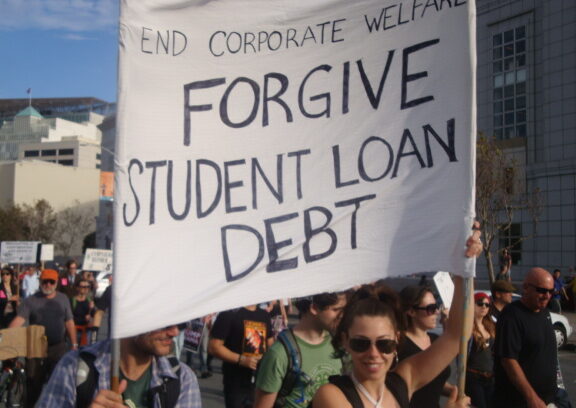In April, the Biden administration announced plans to cancel student loan debt for millions of American borrowers. Intended to “fix the student loan system and make sure higher education is a ticket to the middle class,” this new plan will do none of these things. Instead, it will create a perverse incentive for colleges to raise tuition, students to forgo loan repayment, and future administrations to revisit the issue to score political points. It will also be enormously expensive and subsidize the wealthy and highly educated at the expense of everyone else.
Like its predecessor, this new plan involves the administration taking unilateral action to forgive student loans. This is a problem because the Supreme Court has already determined that the executive does not have such power. Yet, the administration has chosen to push ahead anyway, providing relief in smaller increments.
The details of the plan are pretty straightforward. Meant to complement the expansive SAVE Plan, the plan aims to waive up to $20,000 in accrued interest for borrowers, cancel student debt for borrowers who entered repayment 20 years ago, and eliminate debt for eligible borrowers who didn’t apply to SAVE, among other changes. Unfortunately for taxpayers, the University of Pennsylvania expects the plan to cost $84 billion, not including the $475 billion the SAVE plan is expected to cost. This brings the total price tag of the debt relief handout to more than half a trillion dollars.
This is no small amount of money, meaning that the government will have little choice but to raise taxes, cut spending or borrow more money. None of these are good options for Americans who already pay a significant amount in taxes and are increasingly concerned about the resurgence of inflation, which could be worsened by another government spending spree.
Worse, the latest iteration of the administration’s tax relief plan appears to benefit those who least need financial assistance. The University of Pennsylvania’s analysis of the plan estimates that the plan’s longer-term debt forgiveness component will wipe out debt for 750,000 American households making more than $312,000 in household income. In no world do Americans in this income bracket represent the middle-class families the administration argues it is targeting. Instead, they represent the wealthiest Americans, less than 5 percent of whom make more than $300,000. Consequently, this debt relief plan can only be understood as being a subsidy for the wealthy.
Student loan forgiveness tends to favor highly educated, well-to-do Americans who are more likely to attend university. Many Americans don’t go to college, either because they lack the necessary resources or choose not to. According to the Census Bureau, just 45 percent of Americans age 18 or older possess a postsecondary degree. Yet, on average, these Americans will earn substantially more throughout their lifetimes than their counterparts without a college degree, including up to $1.2 million more for those with at least a bachelor’s degree.
These Americans are also more likely to pursue careers that require more years of schooling, meaning they frequently must take on more debt.
Indeed, research suggests that Americans with incomes greater than the national average hold 48 percent of all student loan debt, with Americans of the highest income percentile (75 percentile or higher) having 26 percent of all debt.
Due to their high earning potential, these Americans are often well-positioned to pay off their debt. That makes sweeping debt forgiveness, of the kind the administration pushes, all the more inexcusable. Why should Americans who did not attend college have to pay for those who did? In addition, why should those who already paid off their student loans — or who never acquired them in the first place — have to pay for those who decided to borrow money? The answer is that they should not.
Borrowers have already received remarkable generosity from American taxpayers. For three years, borrowers were exempted from making payments on their student loans and did not have to worry about accrued interest as a result of a loan pause that was put in place at the beginning of the COVID-19 pandemic. Only in June of last year did Congress finally lift the pause, with payments beginning again in October. Combined, borrowers were shielded from nearly $200 billion worth of student loan payments.
The administration has now decided that this generosity wasn’t enough, despite previously questioning whether he even had “the authority” to forgive student loans. If the administration’s plan is successfully implemented, universities and borrowers will learn all of the wrong lessons. Not only will universities not have an incentive to lower tuition costs but they will have an incentive to raise them since the government is likely to forgive student debt anyway.
Borrowers will no longer struggle to decide whether they should make a loan payment or use their money for other major life obligations, such as to purchase a car or place a downpayment on a house. These are precisely the wrong lessons that the administration should want Americans to learn from student loan forgiveness.
However, probably the most troubling aspect of the administration’s plan to cancel student debt is that it does not get to the root of the problem. While attending university is quickly becoming more expensive, forgiving student debt does not address why it is becoming more expensive. Research suggests that one of the primary drivers is the growth of administrative overhead and university spending on items that are not directly related to instruction such as more student services.
A Department of Education study found that between 1993 and 2009, the number of administrative positions increased by 60 percent, more than 10 times the rate of growth of tenured professors. There is also evidence that financial aid programs may spur tuition increases, as universities have come to expect the government to foot some of the bill for students’ college education and feel safe to raise prices.
Unfortunately, the administration’s debt cancelation plan addresses none of these issues but instead provides wealthy Americans with temporary relief they don’t need. Congress and the courts would be wise to push back on this clear example of executive overreach.


